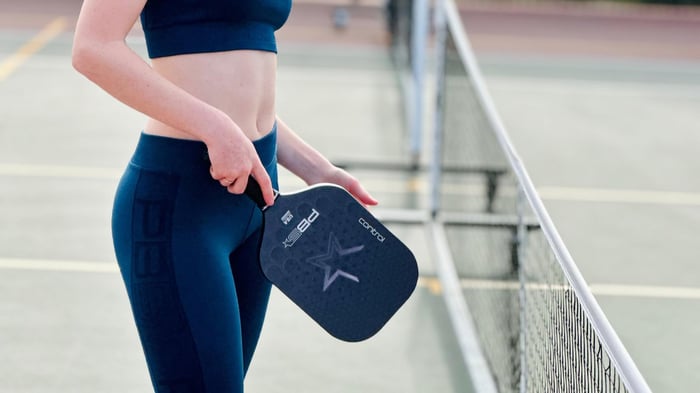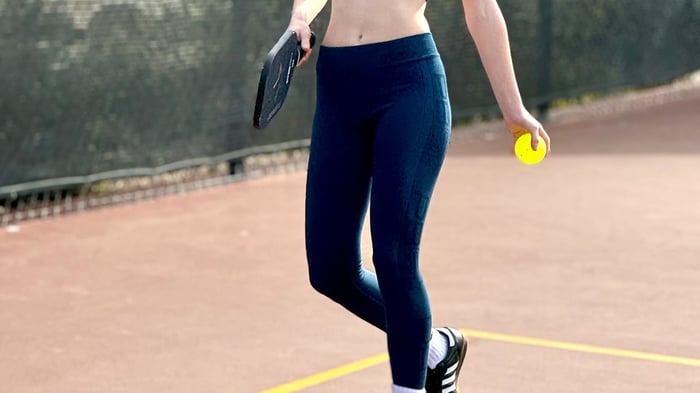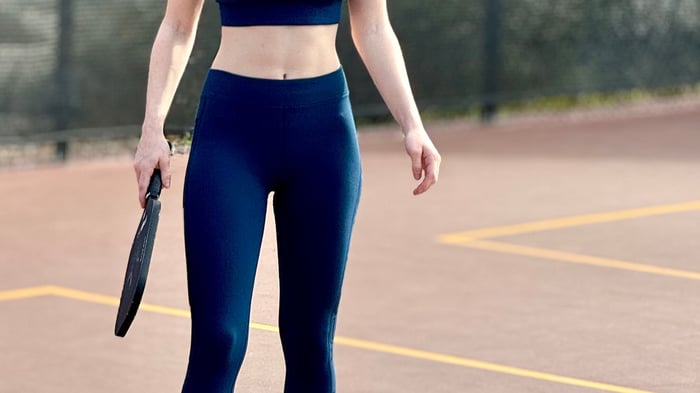Key takeaways:
Cross-training fills the gaps pure court practice can’t reach—building the endurance, strength, and movement control you need for longer, sharper matches.
Full-body training protects you from overuse breakdowns. Strength, cardio, and mobility work together to keep your movement fast and your reactions clean.
Smart training isn't about doing more—it's about targeting the right systems so your game keeps growing without burning out.
Pickleball doesn't give you much time to react. Fast sprints, quick stops, stretched reaches—you're asking a lot from your body every time you step on the court. Over time, that effort builds up in ways you don't always feel right away.
Cross-training mixes different types of movement into your routine—strength work, cardio, mobility drills—so you're building a body that can handle more than one kind of demand on the court. It keeps your movement clean, your reactions sharp, and your body ready to play longer without wearing down.
This guide breaks down the training moves that back up your performance and highlights a few pieces from PB5star's pickleball lineup built to move with you.
Build a body that keeps up with your game
Playing matches teaches you a lot—how to react, adjust, and stay on point. But just playing doesn't cover everything your body needs to hold up over time.
That's where cross-training makes a difference. It gives you the strength, stamina, and flexibility that pure court time can't always build. If you want to move better and stay fresher, adding a little work off the court is also worth adding.
If you want to combine pickleball and cross-training, here's where to start:
Leg and core strength: Strong legs help you push off, sprint, and stay balanced when points get messy. A strong core keeps your movement steady so you can change direction without losing control.
Endurance: Good cardio doesn't just help you last longer. It helps you stay quick and clear-headed when matches run long.
Mobility and flexibility: The easier it is to reach, stretch, and reset, the smoother your game feels—and the less you'll tighten up between points.
Quick-reaction training: Sharp first steps and quick recoveries win a lot of points. Some simple reaction drills can keep your footwork light and your decisions fast.
You don't need to overhaul your whole routine. A little smart training between matches can help keep your movement clean and your energy steady.
Train the way you want to play
Matches move fast. From the first serve, you're sprinting, stretching, scrambling to stay in it. Training off the court should back that up—building the pieces you feel most when games get messy: your first step, your balance when you reach, and how fast you reset after a scramble.
Here's where the work really pays off:
Jump work: Short, sharp lifts—squat jumps, side hops, single-leg pushes—train the quick reactions you need when the ball pulls you out wide or drops just behind you. It's not about how high you jump. It's about how fast you can push off, reach, and stay balanced enough to play the next shot clean.
Agility drills: Quick cuts, ladder drills, short sprints. These sharpen the movements that win points before the rally even starts—your first step to the ball, your quick reset after a stretch, and your ability to shift weight without losing control. Good footwork starts from the ground up, and lightweight court shoes like the PB5 Court2 help keep your movement quick and balanced.
Cardio that holds up: Swimming, cycling, fast walking—steady movement that builds real match stamina without tearing up your joints. It keeps your legs from getting heavy in the second and third hours of play; when footwork gets sloppy, simple shots start feeling harder than they should.
Strength sessions: Steady work on your legs, core, and shoulders holds your game together when rallies stretch long and points get messy. Strong legs push through quick stops and lunges. A steady core keeps your balance tight when you're stretched off-center. Solid shoulders keep your swings quick without breaking down late in a match.
Mobility and recovery: Stretching, rolling, and light movement between heavy sessions keep you moving clean from match to match. Loose hips let you reach. Mobile shoulders keep your overheads strong. A flexible back saves energy late in a tournament when every step feels heavier.
You don't need a packed training schedule. A few focused weekly sessions and court time are enough to stay sharp.
How you time those sessions matters too:
Heavier strength or longer cardio early in the week, when your body's fresher and you've got more recovery time ahead.
Short, sharp agility work as you get closer to matches—enough to stay quick without burning extra energy.
Mobility and recovery sessions around tournaments or heavy playing days, keeping your movement clean without adding more fatigue.
Training shifts with you. Some weeks, you'll push harder, and some weeks, you'll pull back and give yourself more space to reset. The players who stay sharp the longest are the ones who adjust early, stay honest about how they're moving, and let that shape how they train.
Reset your body between matches
When you're playing often or training hard, movements that used to be smooth could start taking more effort. Tightness sticks around longer than it used to. It doesn't always feel like fatigue right away—it builds up slowly.
That’s why recovery is important. It keeps your reactions sharp, your footwork light, and your body moving the way it’s meant to. Without it, you're more likely to feel flat during rallies or sore longer after pickleball matches.
A steady recovery routine helps you stay ahead of that. It backs up the work you’re doing and makes it easier to keep moving well, even after several games.
Here are a few ways to work recovery into your week:
Daily mobility: A few minutes of stretching or light drills keeps your joints moving clean between sessions. Breathable, flexible layers like the Core Performance Tee make it easier to stay comfortable and mobile while you cool down.
Active recovery days: Walks, easy swims, and short mobility circuits—enough to stay loose without further wearing yourself down.
Post-match resets: A few slow laps, targeted stretches for the muscles that worked hardest. Cooling down while you're still warm helps your body bounce back faster.
Full rest days when needed: Real time off isn't a step back. It's where the strength you built actually locks in.
The right habits make everything else feel a little easier and give your body room to recover, so you can keep showing up ready to move.
Frequently asked questions
Training smarter changes how you move and recover, but it also raises new questions once you start feeling the difference. Your routine would look slightly different depending on how much you play, your body's holding up, and what you're working toward. Here's a look at some of the common stuff that comes up when you start building your game.
How long does it take to feel a difference after starting cross-training?
You'll usually notice small changes within a few weeks—quicker steps to the ball, better stretch balance, and a little more energy late in matches. Bigger shifts, like holding your footwork deep into tournaments or recovering faster between points, show up after a few months of steady work. It's not about flipping a switch—it's about stacking small gains until the game starts feeling smoother.
How often should I train if I play multiple times a week?
If you're playing three or more times a week, a couple of smart sessions—like two strength days and one agility day—is enough to keep you moving forward without burning you out. The idea isn't to cram more in. It's to cover the parts court time misses and keep your body ready for the matches that matter.
What's the best way to recover between back-to-back tournament days?
Keep it simple: light movement to stay loose, plenty of water, good food, and real sleep. A short walk and some mobility work right after you finish playing can clear a lot of tightness before it settles in. Full rest sounds good, but staying gently active helps your body bounce back quicker for the next day.
Do I need different training in the off-season versus peak season?
Yeah—you don't train the same way year-round. Off-season is the time to push harder in the gym, build strength, and work on bigger movement patterns. During peak season, training shifts into maintenance mode—lighter strength work, sharper footwork drills, and more focus on staying fresh for matches.
How can I tell if my training is helping my game or just making me tired?
The best sign is how you move during matches. If your first steps feel quicker, your balance is steady under pressure, and your movement feels clean even when points stretch longer, the training works. If you're dragging into points or feeling flat even after rest, it's a sign you're overloading and need to back off a little.
Keep building a game that lasts
There's no shortcut to building a game that holds up over time. It's steady work—training the right pieces, letting your body reset when needed, and making small adjustments that add up over weeks and months. The goal isn't chasing perfect days. It's building a game that stays steady when everything else starts to slip.
PB5star builds gear that's made to back you up through all of it—the work, the resets, and the stretches that push your game forward.







